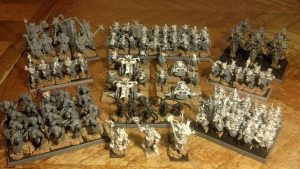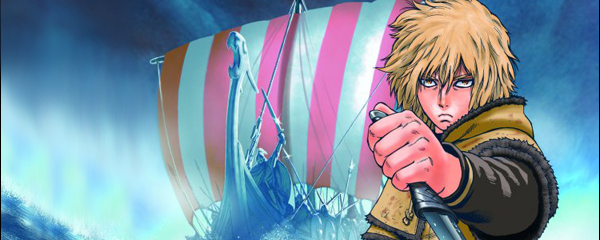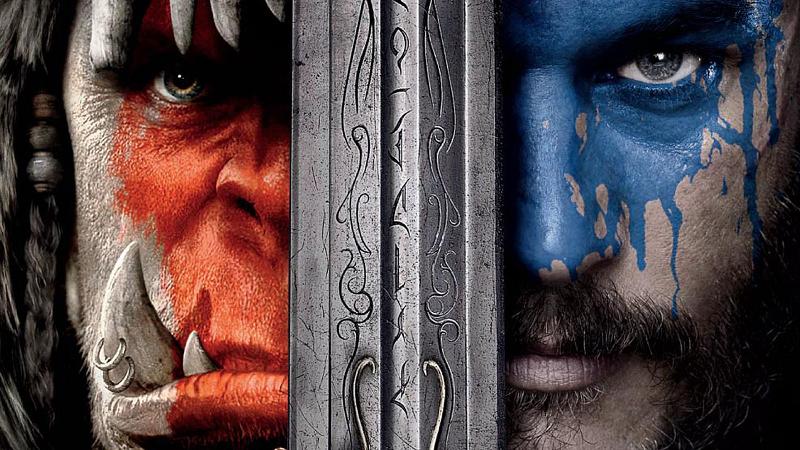Not all is well in the Old World. The End Times have come and gone. Heroes lie beaten and forgotten to history and the world had literally come to an end. For some, it marked a new beginning. For many, it was the end of the road. Apocalyptic perhaps, but for the people who played, and loved Warhammer Fantasy, the new core set that they called The Age of Sigmar became the final nail in the coffin of their hobby. It was supposed to increase sales by simplifying many of the (sometimes arcane) rules; and allow players to build the forces that they wanted to play with. But in the eyes of many in the community, Games Workshop made a mistake. The core game changed too much this time, and many aspects of Warhammer Fantasy that people had enjoyed were gone.
I know that the Warhammer Fantasy fandom is not on many radars. But that’s missing the point. What this story is about, is what do you do when the thing you love stops being the thing that made you love it? Really, it could be anything, any fandom and any hobby – even yours. What Warhammer players are asking right now, is what do you do when the company that was responsible for a hobby you love, goes somewhere you don’t want to follow?
Waging Warhammer
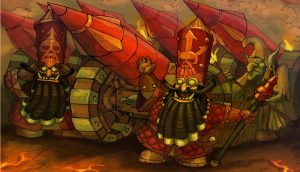
It was the goofy hats that did it for me. I didn’t know what Warhammer Fantasy Battles was, but I had a friend that played and he had friends that all played and it all seemed, somehow, cool. 13 year old me knew very little about it at the time, yet the idea of commanding hundreds of troops on a field of battle, led by heroes and monsters that could bring the down the (sometimes literal) thunder appealed to me on a deep, and previously unknown level. So I stood at my local hobby shop with birthday monies gripped in my hot little hands and a choice that I had to make; what army do I like? Eventually, Chaos Dwarfs won the day and my heart.
My army never quite grew past the first dozen Half Pints and their rocket launcher I bought, nor did my battle experience ever evolve past small skirmishes. Even still, Warhammer had left its mark on me and I continue to enjoy watching the hobby from afar. Since that fateful day at the model store, 5 more editions of the Core Rules for Warhammer came and went. Each time the armies were updated (or in the case of by beloved Chaos Dwarfs – discontinued) and the hobby continued. Players may have griped about balance adjustments but were usually content to make use of the new rules and continue to enjoy their hobby as they always have. Oh yes, on a certain level Warhammer Fantasy Battles is as much a hobby as it is a game. The pieces come unpainted, and often, unassembled; so the very act of putting your massive force together can take weeks. Suffice to say that people can become very attached to their armies and will often play them with friends or at their local shops for years.

But at its core, Warhammer is about units. A unit is a collection of troops on the field, arranged into a box formation. In Warhammer each unit is equipped with the same weapons and armor, and this can have a great effect on how they function. A unit of Elves with bows is going to function a lot differently than a unit of Skaven with swords and shields. What’s important is that each unit acts as a single group. So they turn as one, march as one, and fight more or less as one. This creates a situation where players do not need to micromanage individual troops, and instead focus on the positions and general welfare of their units in the field. It’s like the difference between playing Warcraft and Total War.
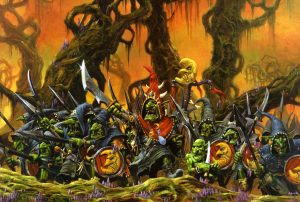
Quite a bit of the fun of Warhammer actually happens when players are constructing their armies. In order to balance out the sides and make for fair games, Warhammer uses a system of point values. Something like a goblin may be worth 3 points, but an Elvish Hero might be worth 300 points. It makes a weird sense if you think about it, since if Legolas was up against 100 goblins you’d think, “Oh, that seems like it would be fair.” So it’s possible to field a few hundred dudes and go up against somebody with some elite troops and a couple of dragons and still have an interesting, balanced, game.
The thing is that everything costs points. Want to give everybody bows? That’ll cost you. Shields? Points please. How about one of those banner things so they don’t get all scared and run off? Hope you brought your credit card, ’cause that’s going to be some points. Some players decide to use their allotment and create expensive troops that can do everything. Others instead build armies full of cheaper specialist units that are good at one thing but vulnerable doing anything else.
Finally, Warhammer included a variety of races. You can play with Elves (High Elves, Dark Elves, and Forest Elves), Dwarves, Skaven (rat people), Lizardmen, the Human (and vaguely German) Empire, Orks, Beastmen, (kinda French) Knights, Undead, and the Forces of Chaos. If nothing else, you can now appreciate the indecision that 13 year old me had at the hobby shop. What’s fun is that each of these had different troop types, different strategies and access to different monsters and heroes. In effect they all play wildly different from one another and can be made to function differently still based on how a player builds their army. Two players can both come in with Orks and have forces that look nothing alike (except for the green skin, ‘natch).
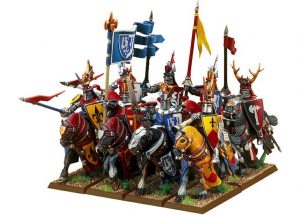
When you combine these facets together, Warhammer had a level of customization and flexibility that was truly astounding. Then once the armies are painted and on the field, players got to try to figure out what their opponent’s troops and formations are capable of doing. A good commander would work to maximize the strengths of their army while avoiding the sharp parts of their opponent’s. It was, for lack of a better word – fun. There’s something really wonderful about moving your troops into position, and breaking your opponent’s line with a well placed charge, and if as a gamer you’ve never pulled a Hannibal, you’re seriously missing out.
The (Dark) Age of Sigmar
Yet, there was an issue with Warhammer Fantasy Battle, nobody was really buying much. There are a bunch of reasons for this, but the first has to do with the barrier of entry. Let’s say that everything I said above sounds great and you can’t wait to get your hands on some Warhammer models and start playing. First you’d need to buy a the rule book, and then each army has their own book, so already you’re at $100+ before you’ve even looked at buying your first Bel-Hathor with the Good Hair. Warhammer Fantasy’s rules about units and formations also makes it harder to field an army. It’s not easy to pick up a few models and play, since the rules encourage forming groups. So in order to play, you need to purchase a few dozen units just to start, which can be another few hundred dollars. Then once you have your heroes and you buy all the troops, they look like this:
Aesthetically, the term that describes an unpainted Warhammer army is that it “Looks Like Ass.” Yes, it turns out that the box lied to you and your dudes don’t all look like that. This means that the next part of the Warhammer hobby is that you get to paint your guys. This is both good or bad depending on your point of view. On the one hand, you can customize the colors, banners and everything else and really make your army unique. On the other, painting them can take a really long time, and this is from somebody that usually likes that sort of thing. To be fair, there are some people that enjoy the painting aspects as a focus in and of itself, but for a newbie, it can be downright daunting.
In short, to play Warhammer a player needs to buy books, a whole lot of figures, and then have dozens of hours available to paint them. These facets came together to create a situation where fewer people were getting into the hobby at all which is, if you’re trying to be a company that makes money, bad. These were some of the factors that led Games Workshop to reconsider how the game functions, and directly led to the creation of The Age of Sigmar.
The first thing that they did, was to basically get rid of the concept of fielding armies. No longer would players be tied only to their army, but can freely mix whatever factions they would like. Orks and Dwarves together, or Demons and Elves, it didn’t matter, and from a certain perspective, this makes sense as a way to encourage new players. Now they can purchase a couple of starting pieces that they think are cool for whatever reason (the hats perhaps) and play with those.
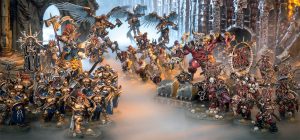
Additionally, the concept of points was eliminated. Instead it was replaced by a system referred to as “Sudden Death.” It works like this: Each player takes turns putting down a unit on the table until they are happy with the army that’s there. However, once a player has stopped their opponent can continue to place as many units as they want. It’s not entirely out of the realm of possibility that the game starts off with one player being wildly outnumbered. If they have 1/3 more models, the other player can declare Sudden Death, and be able to win by fulfilling a single objective. It’s supposed to be a system to encourage fair play, and again, if you’re trying to get people to play without a crazy barrier to entry, it is doing that. Without points, players don’t need to create their army lists and deal with all of the miniature minutiae that regular Warhammer required.
Finally, to encourage being able to play with smaller number of troops, Games Workshop stopped supporting the massed formations in the rule set. Instead of having your people all in tight little boxes, instead each soldier is their own unique entity. For newcomers, this allows them to not be required to buy (and paint) the dozens of units that can go into a single group. Instead they can show up with the guys they have and play a game with them. In effect, The Age of Sigmar seems designed from the ground up to get more people into the game. Which, from a purely business perspective is possibly the right move for the long term survival of the hobby.
Upon seeing the changes in The Age of Sigmar, long time players took a moment, reflected, and lost their fucking minds.
The Schism
Across the interwebs, the cries of rage echoed. The anguish echoed through the forums and the comments sections. The tabletop gaming press did reviews of Age of Sigmar. The results were, to put it charitably, slightly less positive than a spring outbreak of herpes test. Nerdhammer.net concluded, “Age of Sigmar feels like a slap in the face, punch in the gut, and kick in the balls all at once,” and that’s not the worst thing said about the game. Joe Perez for The Escapist wrote that the “lack of precise care takes away from the player’s ability to enjoy the game: I saw veteran players grow incredibly frustrated trying to use carefully-assembled forces.” The reviews tend to be brutal if coming from the perspective of established players of Warhammer, and slightly less damning if the new player is instead considered.
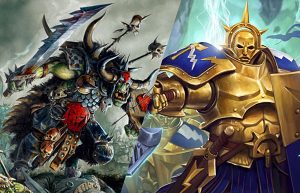
Age of Sigmar is, in and of itself, not a terrible game. For players that could get past the the fact that it wasn’t Warhammer, it is apparently a shallow, if somewhat enjoyable experience. For the long term players, too much had been changed. “In my opinion, WHFB was always designed as more of a complex, competitive game than a casual game. AoS seems like a crap shoot that removes a lot of the careful strategic planning necessary to win WHFB,” wrote one disgruntled Geekdad commenter, and their point was common in other threads as well. Basically, the things that made Warhammer unique had been stripped out. To put this in perspective, imagine if Dr. Who abandoned the time travel and instead focused on The Doctor being an actual doctor that never leaves Miami and is played by Luke Wilson. Or if Star Wars stopped being about good and evil and instead was about galactic politics. Oh wait, they did that. It went great.
The lack of points was something that players derided. It would be like if players could play chess with whatever they had brought with them. Or if Magic got rid of the 60 card decks and the 4 card per deck maximum. Yes, some players may enjoy the result, but for most players they would feel like something intrinsic to the game had been destroyed. After all, if limitation breeds creativity, the lack of it creates a game where people simply play with the “best” stuff. Taking away the balancing of the point system did simplify the game, but left it with a shadow of its former interesting complexity.
The lack of complexity and interesting choices is something that can kill a game. Yet the position of Games Workshop needs to be considered. They are a game company and their goal is to have as many people playing their game as possible. Sigmar was designed to reduce the barrier for new players, even though it royally pissed off the fanbase. It’s a common occurrence in the game industry as a whole – players like a weird, complicated thing because it is weird and complicated. But the game doesn’t sell well. So when the company makes it less complicated so that new players can enjoy it too, the old guard cries foul.
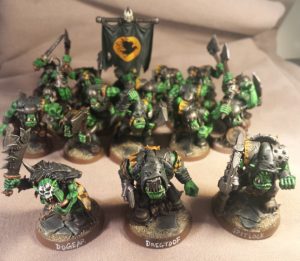
The weird thing is that nobody is really wrong. A game company that doesn’t try to expand their player base is going to eventually go out of business. At the same time everything that people love has, at its core, a thing that spoke to them. For Warhammer players, it was all of those choices, and the customization that you could manage with your army, and the lore behind it all. In other words, it was all the things Games Workshop got rid of to bring new players into the fold.
But Warhammer was also a lot more than that – there was a community. Players would gather in game stores and show off the paint job of their newest figures. They would talk about the books, and they would field new permutations of their units and try new tactics. This of course says nothing about the costs that faithful players invested: “I know a lot of people think this is just a game and we are overreacting, but think about it. I dropped more than $20k over 12 years on this. This was a major part of my life as far as hobbies go,” said one player, while another added, “If this is what they do to customers who have that sort of investment in the game, I can’t see myself spending any more money with them.”
What happened next was strange, and to a certain extent, as profoundly heartening as it was saddening. Players didn’t want to lose what they had. They’d invested too much time, and money, in the game that they loved. They had friendships that they formed from the Warhammer community.
Many of them decided to keep on playing the most recent edition of Warhammer, 8th. But in those groups a feeling of malaise seems to permeate, not unlike the Elves in Lord of the Rings. They know that there will never be a new edition. On a crunchy gameplay level, armies will not get balance tweaks and units will not get stat updates. On an esoteric level, they know that their world has died. There will never be new heroes and no new villains will spawn to challenge them. No empires will rise, and no WAAAAGHs will be called. So yes, players can continue to play the game that they loved, but it eventually it will be naught more than a curiosity. If this sounds a tad on the dramatic side, consider this: how many people still go online to play Halo 3?
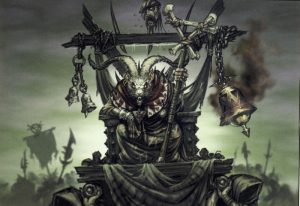
Others have decided that they are willing to play Sigmar. The gameplay might be different, but it can still be a fun experience. These players see what they have and are willing to give it a shot. They see that, for all of the changes made, new people are playing The Age of Sigmar. The simplified rules are allowing people access of a less complex entry point. The message boards are also filled with people that are trying to create systems to put back the missing parts that Sigmar left behind. They talk of balancing and the creation of de facto point systems, while speaking of a core game that is sound, but in need of improvement. In all it seems like these are the people most trying to keep the community together. “Look,” they say, “The Age of Sigmar can be a very good game! We just have to agree on tweaks.”
For others, the knowledge that Games Workshop is willing to, seemingly on a whim, blow up their hobby is too much to forgive. Instead they’re looking for a fully supported game that has many of the same systems that Warhammer had. A game by Mantic called Kings of War was the answer. It began as a Kickstarter and grew into a fully fledged game and features robust books, a points based balance system and a general focus on large scale, formation based combat. The rules are also available online for free. They’ve even gone so far as to include armies that had been discontinued by Games Workshop, specifically my beloved Chaos Dwarfs (called Abyssal Dwarves because, well, copyright). The greatest downside is that while their rules can be used with many existing Warhammer armies (sorry Skaven and Lizardmen) their miniatures cannot be used at Games Workshop based events, which limits access to the larger community. Of course, unlike Warhammer Fantasy, Kings of War is a supported product by a company that really seems to care about making their player base happy. This means that updates and new armies will probably be forthcoming.
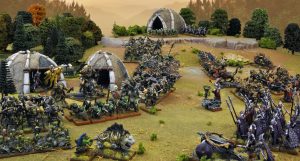
 Of course, sometimes a gaming community refuses to let a game just die. In this vein an intrepid band of Warhammer tournament players and game designers began work on a project called The 9th Age. It is, for all intents and purposes, the 9th Edition of Warhammer. The core rules were taken and updated with a focus on making the game more user friendly without changing the experience. The changes are esoteric if you’re unfamiliar with the nitty gritty of 8th Edition, but for long time players the updates are welcome. For them, 9th Age is the 9th Edition that they had been hoping for. Much like Kings of War, they also support armies that had been discontinued (like Bretonnia, called the Kingdom of Equitaine because- copyright). What is interesting about 9th Age, is that this is a rules system only. There are not standard miniatures, and so players can mix and match whatever company lines they would like to use to make their armies look like they want them to. This also means that existing Warhammer players can use what they have and just get the (free) army books online.
Of course, sometimes a gaming community refuses to let a game just die. In this vein an intrepid band of Warhammer tournament players and game designers began work on a project called The 9th Age. It is, for all intents and purposes, the 9th Edition of Warhammer. The core rules were taken and updated with a focus on making the game more user friendly without changing the experience. The changes are esoteric if you’re unfamiliar with the nitty gritty of 8th Edition, but for long time players the updates are welcome. For them, 9th Age is the 9th Edition that they had been hoping for. Much like Kings of War, they also support armies that had been discontinued (like Bretonnia, called the Kingdom of Equitaine because- copyright). What is interesting about 9th Age, is that this is a rules system only. There are not standard miniatures, and so players can mix and match whatever company lines they would like to use to make their armies look like they want them to. This also means that existing Warhammer players can use what they have and just get the (free) army books online.
What’s is saddening however, is that the community has been shattered into so many different groups. Players that had once played Warhammer had a common ground to talk about their hobby. Now, with the proliferation of games looking to replace it, that may no longer be the case. If nothing else, the official store support offered by Games Workshop is gone, so either players continue with 8th Edition, or they make the change to Sigmar. Of course, it’s possible that each of these games will be a success in their own right. It’s also possible that because each game shares so many characteristics that players will simply take an army and play all of the systems. I mean, if a player can build a 2000 point army of marauding Orcs/Orks/Greenskins and use them in whatever wargame is hosted at a store, it seems like that would be pretty great. Perhaps it would be a renaissance of sorts. But honestly, the wargaming community is not exceptionally large. Devoted yes, but not terribly numerous. The more likely outcome is that slowly, players will find that the groups that they were part of will dwindle. New players will have all of the barrier of entry they had before, but now they won’t have a thriving community to be a part of once they make the leap. Instead they’ll see the colorful boxes with the painted miniatures and heroes, and they’ll put their money back into their pocket.


